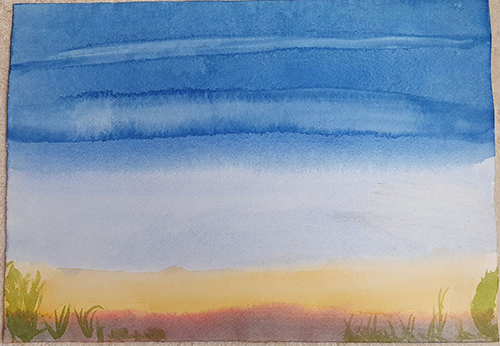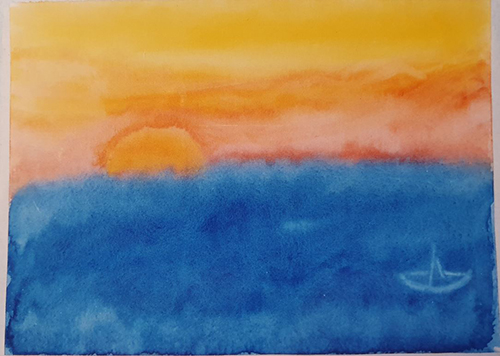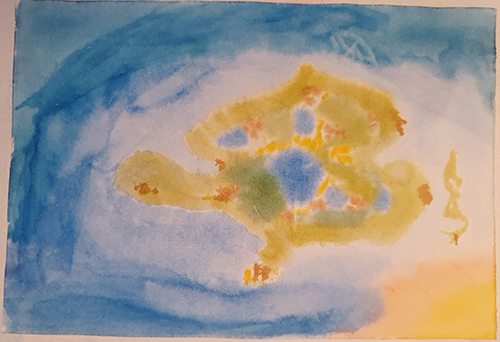Painting Therapy to Support and Care for the Consciousness of Palliative Patients
Dagmar Brauer, Astrid Didwiszus
Last update: 20.11.2020
Whether it is in the context of a palliative care unit, a hospice or a home visit: both active and receptive painting therapy can help to give expression to the soul and consciousness of a terminally ill person in the last phase of life. Entrusting this inner process to color on a piece of paper as a “witness” is an individual and intimate process and the resulting painting is often unpredictable. The resulting picture can trigger a wide range of responses in the painter – from feeling pleased, surprised or relieved to being stunned and thoughtful.
The patient’s coming detachment from earthly conditions, which is being prepared by his or her developing illness and changing consciousness in the palliative situation, can be reflected in the pictures painted. Colors, forms and dynamics may increasingly diminish. Often depictions of the earth recede in favor of the sky. We can then offer simple, unambiguous motifs which the person painting may relate to or want to take up. On the other hand, this situation can also give rise to pictures whose motifs show a final “grasping” of life in the form of more intense colors and dynamics. Wherever the personal pictorial expression goes, it is carried by the attitude of the art therapist, who believes that the paths and forces of human development can be promoted and nurtured in this way.
Therapeutically, the seriously ill person must be accompanied attentively, gently, warmly and calmly. The focus is on his or her physical, emotional and cognitive needs and sensitivities, and he or she decides what is possible – with or without words. Art therapists learn to assess this appropriately and to face their own emotional challenges in this situation. Building a sincere relationship and offering trust and comfort are the most important basics for the encounter.
The therapeutic environment
Comprehensive, competent palliative support from doctors and nurses is indispensable as a basis for providing art therapy when accompanying seriously ill or dying people. Only when the patient is as comfortably bedded as possible, has as little pain as possible, and when basal needs such as thirst have been satisfied, can the therapeutic encounter begin.
Often the painting will take place in bed and appropriate materials must be considered.
The goals of painting therapy are:
- Support in processing and coping with the disease-related symptoms.
- Support in resolving mental and spiritual challenges and questions.
- Support in the process of dying and saying goodbye.
The paintings
In palliative inpatient painting therapy, pictures are often created that are a deep expression of the patients’ perceived processes of consciousness and transformation: pictures of life, hope, fairy tales, safe places and farewell pictures.
Pictures of life: Especially younger patients with a serious prognosis want to paint life pictures and life memories. They bring their own ideas of what they want to paint and we support them artistically and therapeutically in doing so, enabling them to give away (bequeath) their pictures with satisfaction.
Pictures of hope: Even in palliative treatment, images of hope can arise: a warm yellow light in the center of the picture, enveloped by transparent blue. A light red horizon over a green hill. A gently undulating blue ocean. An open colored gate. The sun. A rainbow. A tree as part of the natural cycle. It can also be any color or motif which the patient associates with a personal sense of hope.
Fairy tale pictures: Patients who are close to death often remember threshold experiences in their own biographies and feel the working of fate. Motifs from the fairy tales of the brothers Grimm, which provide identity, consolation and healing, lend themselves to working through such feelings in painting.
Safe places: The desire for protection and security is a great need in terminally ill people. Even an image of a safe place, painted in a single session and experienced as successful, can strengthen their sense of well-being. Form drawing can also be helpful for this. The therapist hangs the picture up in the hospital room so that the patient can look at it.
Farewell pictures, the “last” picture: Which picture will be the last one for a palliative patient? This is not predictable. The individual courses of the illness are too different for that and the great metamorphosis in which people find themselves between life and death is too intimate. In the many years of experience of working with patients, certain signatures have nevertheless been noticed in patients’ “last” pictures: water, a flame, a seed of color, a gate.
Through art therapy, the seriously and terminally ill person can open up a new, directly experienceable sense in themselves.
A patient’s last painting series
The following three pictures by a 72-year-old breast cancer patient were created two months before she died. They are the last ones that she painted. For more than four years she had come for painting therapy during her inpatient chemotherapy stays. The first picture shows a motif that the patient chose to paint. In the second picture she takes up a therapeutic suggestion to “reverse” the colors, painting the light color on the horizon and the water (sea) adjacent to it. It was exhausting for her, but the finished picture touched her deeply. For a long time she thought about how and where she could put the little ship (which was part of the therapist’s suggestion). The third picture shows a bird’s eye view of an island; the patient then said that she did not want to paint any more.

Fig. 1: Free painting by a 72-year-old breast cancer patient in a palliative situation.
© Dagmar Brauer

Fig. 2: Painting by a 72-year-old breast cancer patient in a palliative situation, following a suggestion by the therapist. © Dagmar Brauer

Fig. 3: The last painting of a 72-year-old breast cancer patient two months before her death. © Dagmar Brauer